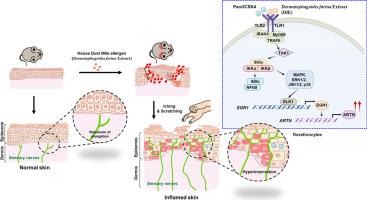当前位置:
X-MOL 学术
›
J. Invest. Dermatol.
›
论文详情
Our official English website, www.x-mol.net, welcomes your feedback! (Note: you will need to create a separate account there.)
The EGR1–Artemin Axis in Keratinocytes Enhances the Innervation of Epidermal Sensory Neurons during Skin Inflammation Induced by House Dust Mite Extract from Dermatophagoides farinae
Journal of Investigative Dermatology ( IF 6.5 ) Pub Date : 2024-02-01 , DOI: 10.1016/j.jid.2024.01.017 Hyunjin Yeo , Sung Shin Ahn , Sukjin Ou , Sook Jung Yun , Yoongho Lim , Dongsoo Koh , Young Han Lee , Soon Young Shin
Journal of Investigative Dermatology ( IF 6.5 ) Pub Date : 2024-02-01 , DOI: 10.1016/j.jid.2024.01.017 Hyunjin Yeo , Sung Shin Ahn , Sukjin Ou , Sook Jung Yun , Yoongho Lim , Dongsoo Koh , Young Han Lee , Soon Young Shin

|
Epidermal hyperinnervation is a critical feature of pruritus during skin inflammation. However, the mechanisms underlying epidermal hyperinnervation are unclear. This study investigates the role of the transcription factor EGR1 in epidermal innervation by utilizing wild-type () and -null () mice topically applied dust mite extract from (DfE). Our findings revealed that mice exhibited reduced scratching behaviors and decreased density of epidermal innervation compared to mice. Furthermore, we identified artemin (ARTN), a neurotrophic factor, as an EGR1 target responsible for DfE-induced hyperinnervation. It has been demonstrated that DfE stimulates toll-like receptors (TLRs) in keratinocytes. To elucidate the cellular mechanism, we stimulated keratinocytes with Pam3CSK4, a toll-like receptor (TLR) 1/2 ligand. Pam3CSK4 triggered a TLR1/2-mediated signaling cascade involving IRAK4, IKK, MAPKs, ELK1, EGR1, and ARTN, leading to increased neurite outgrowth and neuronal migration. Additionally, increased expression of EGR1 and ARTN was observed in the skin tissues of patients with atopic dermatitis. These findings highlight the significance of the EGR1-ARTN axis in keratinocytes, promoting the process of epidermal innervation and suggesting it as a potential therapeutic target for alleviating itch and pain associated with house dust mite-induced skin inflammation.
中文翻译:

角质形成细胞中的 EGR1-Artemin 轴增强了粉尘螨提取物引起的皮肤炎症期间表皮感觉神经元的神经支配
表皮神经支配过度是皮肤炎症期间瘙痒的一个关键特征。然而,表皮神经支配过度的机制尚不清楚。本研究利用野生型 () 和无效 () 小鼠局部涂抹 (DfE) 尘螨提取物,研究转录因子 EGR1 在表皮神经支配中的作用。我们的研究结果表明,与小鼠相比,小鼠的抓挠行为减少,表皮神经支配密度降低。此外,我们确定了神经营养因子 artemin (ARTN) 作为 EGR1 靶标,负责 DfE 诱导的过度神经支配。已证明 DfE 可刺激角质形成细胞中的 Toll 样受体 (TLR)。为了阐明细胞机制,我们用 Pam3CSK4(一种 Toll 样受体 (TLR) 1/2 配体)刺激角质形成细胞。Pam3CSK4 触发 TLR1/2 介导的信号级联,涉及 IRAK4、IKK、MAPK、ELK1、EGR1 和 ARTN,导致神经突生长和神经元迁移增加。此外,在特应性皮炎患者的皮肤组织中观察到 EGR1 和 ARTN 表达增加。这些发现强调了 EGR1-ARTN 轴在角质形成细胞中的重要性,促进表皮神经支配过程,并表明它是减轻与屋尘螨引起的皮肤炎症相关的瘙痒和疼痛的潜在治疗靶点。
更新日期:2024-02-01
中文翻译:

角质形成细胞中的 EGR1-Artemin 轴增强了粉尘螨提取物引起的皮肤炎症期间表皮感觉神经元的神经支配
表皮神经支配过度是皮肤炎症期间瘙痒的一个关键特征。然而,表皮神经支配过度的机制尚不清楚。本研究利用野生型 () 和无效 () 小鼠局部涂抹 (DfE) 尘螨提取物,研究转录因子 EGR1 在表皮神经支配中的作用。我们的研究结果表明,与小鼠相比,小鼠的抓挠行为减少,表皮神经支配密度降低。此外,我们确定了神经营养因子 artemin (ARTN) 作为 EGR1 靶标,负责 DfE 诱导的过度神经支配。已证明 DfE 可刺激角质形成细胞中的 Toll 样受体 (TLR)。为了阐明细胞机制,我们用 Pam3CSK4(一种 Toll 样受体 (TLR) 1/2 配体)刺激角质形成细胞。Pam3CSK4 触发 TLR1/2 介导的信号级联,涉及 IRAK4、IKK、MAPK、ELK1、EGR1 和 ARTN,导致神经突生长和神经元迁移增加。此外,在特应性皮炎患者的皮肤组织中观察到 EGR1 和 ARTN 表达增加。这些发现强调了 EGR1-ARTN 轴在角质形成细胞中的重要性,促进表皮神经支配过程,并表明它是减轻与屋尘螨引起的皮肤炎症相关的瘙痒和疼痛的潜在治疗靶点。



























 京公网安备 11010802027423号
京公网安备 11010802027423号